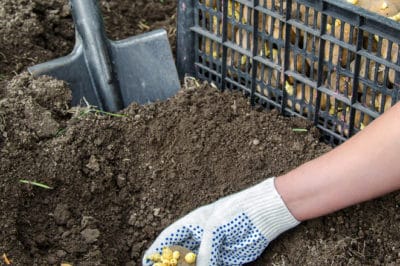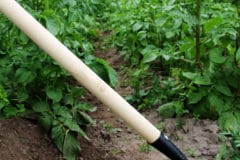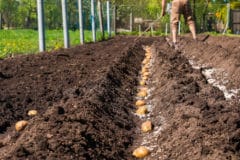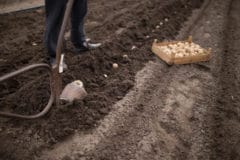Potato Growing Basics
The potato is a cool-season crop and most do best when planted in early spring. They prefer soil slightly on the acid side, with good drainage. The texture should be loose and friable, so add plenty of humus, especially in clay soil. Soil should also be rich in potassium and nitrogen. Water regularly while the plants are growing. Keep the weeds down; potatoes don’t do well with competition.
Why Depth Matters
Potatoes form tubers along the length of the underground stem. If you plant too shallowly, the tubers can be exposed to the sun. Potatoes that are green were not planted deep enough and have developed a toxic substance called solanine from sunlight exposure. Gardeners cover potatoes with soil – hill them – and it’s harder to hill plants that are too shallow.
Preparing the Soil
No matter how you plant them preparing the soil properly is the key to growing good potatoes. The roots and tubers need loose soil to develop properly. If you have heavy clay, add lots of humus, such as well-rotted leaves, aged manure or organic compost. Wood ashes sprinkled lightly on the ground add potassium, and amendments such as bone meal, kelp and greensand add to soil fertility. Dig or rototill so the soil is friable.
Choosing Varieties
You can plant early, mid-season or late potatoes. Potatoes are also available in different colors, as fingerlings and in heirloom varieties. Here are some possibilities.
- Early Season – Caribe, Irish Cobbler, Norland, Yukon Gold
- Mid-Season – All Blue, Carola, Kennebec, Russet Burbank, Yellow Finn
- Long Season – Katahdin, Bintje, German Butterball, Green Mountain.
Dryland Planting
When you garden without irrigation and rely entirely on rain or natural soil moisture, you need to make some adjustments to your planting practices. Plant a little more deeply – there should be more soil moisture at that level. Space your plants farther apart in the row so they don’t have as much competition for water and nutrients.
Planting in Mulch
Ruth Stout was a gardener writer who popularized the idea of planting under a permanent mulch. Stout never dug ground for her potatoes. She lifted the mulch, placed the seed potatoes underneath and continued to add more mulch – usually plain straw – as the potatoes grew. Some gardeners plant in a trench and then mulch the potatoes in the trench rather than covering with soil.
Shallow Planting
If you live in a short-season area or are anxious for those first spuds, dig your holes about four inches deep and place seed potatoes in them about 12 inches apart. In warm soil, these shallowly planted potatoes will emerge in two to four weeks. However, once the plants are about six inches tall, you must hill them by covering with soil, repeating at least twice.
Deep Planting
Deep planting – eight to 10 inches – decreases the amount of work you have to do and makes it easier to cover the plants with soil as they grow. Dig the holes to the proper depth, place your potatoes in the trench about one foot apart and cover them to ground level with loose soil. These potatoes will probably not require hilling, but it will take them longer to breach the soil and to develop tubers.
Shallow vs. Deep
There are times when shallow planting is better. If you live in a cold area or are planting late in the season, go shallow. These potatoes will sprout more quickly and grow faster because they don’t have far to travel to the light. If the soil is very cold and wet, shallow is better; otherwise they may rot. However, if you’re dryland farming, slightly deeper planting increases the chance of moist soil around the roots.
Trench Planting
There are several advantages to trench planting. First, you can ensure the soil is completely loose and friable all the way down. Second, you can give the bottom of the trench a good watering before you plant. The deep sides of the trench help hold moisture, especially in dry, windy areas. Third, you don’t need to hill the potatoes above-ground – you simply fill in the trench as they grow.












